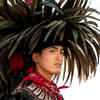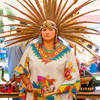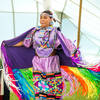



The Sacred Springs Powwow is the largest two-day outdoor powwow in Texas and it happens in San Marcos, this year on November 17 and 18 on the shores of the headwaters of the San Marcos River. The event is produced by local nonprofit Indigenous Cultures Institute and funded by the San Marcos Arts Commission, the Tomblin Family Foundation, Texas Commission on the Arts, and Friends of the Powwow.
For the past seven years crowds have gathered at what locals call the “sacred springs” to witness the morning opening of powwow festivities featuring a blessing ceremony performed by elders from several indigenous communities.
The springs are considered sacred by some Coahuiltecan Native Americans because they believe that during creation, they traveled the underworld as spirits and finally emerged from the springs onto Mother Earth as “the People.”
The rest of the day after the blessing and the following Sunday is filled with over one hundred Native dancers, fifty vendors in a Native American Market selling arts, crafts and indigenous foods, guest performances by visiting Native tribes’ musicians and dancers, and presentations on Native American history and other topics.
This year will be the eighth year of this Native American celebration that actually started twenty-three years ago. In 1995, local music celebrity and attorney Lucky Tomblin hosted a welcome back to Native American tribes that had once roamed the Texas area.
With the help of a Kiowa elder, Tomblin founded the first-ever Sacred Springs Powwow in San Marcos.
According to a past newspaper article, this first event featured powwow contest dancing with thousands of dollars in prize money, performances by legends of Western Swing, the Western Swing Awards, and Hall of Fame inductions.
“We visited Lucky and Becky Tomblin and asked their permission to re-establish the Sacred Springs Powwow,” says Dr. Mario Garza, the institute’s board of elders chair. “He not only gave his permission, but the Tomblin Family Foundation has been a steadfast supporter all these years. Lucky has since passed and we continue to honor his memory at every powwow.”
The current powwow started as a one-day event and has expanded to two days to accommodate the growing number of Native dance contests, educational presentations, visiting performers, art vendors, and general public who come to celebrate indigenous culture.
“On Saturday, we’re having a Native American clothing show featuring traditional and modern-day apparel by internationally acclaimed designer Nan Blassingame (Southern Cheyenne),” says Maria Rocha, the institute’s executive director. “Her work was featured this year at the Austin Intercultural Fashion Show, as the first Native American accepted into this prestigious event.”
After the Austin show Blassingame attracted the attention of “Art Today” magazine in London, which resulted in an interview article published in April.
Her popularity has grown and now she’s receiving invitations for new showings of her work. Blassingame will also be featured as the Head Lady Dancer at the Sacred Springs Powwow.
Another first-ever performance at this year’s powwow will be the Taino dancers presenting drumming and dancing indigenous to the Puerto Rico area.
The Taino people were among the first Native Americans encountered by Christopher Columbus when he came to the Americas.
They are part of the Arawakan Native Americans in northeastern South America. The dance group practices ancient Taino dances from their heritage and is based at the Puerto Rican Cultural Center in Austin.
“Taino dancing is very different from powwow and Aztec dancing,” says Rocha. “They have an impressive array of drums that set the pace for the dancers; and the communal-style steps move and flow with energy and beauty.”
Powwow and Aztec dancers will be the center stage of the powwow as they compete for championships as best dancers in several categories. Powwow men will compete in the categories of “Traditional,” “Straight,” “Grass,” and “Fancy.” Powwow women will compete in “Cloth,” “Buckskin,” “Jingle,” and “Fancy Shawl.” Aztec dancers will compete for “Most Honored Man” and “Most Honored Woman.” Preliminary dancing will take place on Saturday, with the best dancers elevated to final competitions on Sunday.
This year’s Native American Market will draw many more vendors from New Mexico, Arizona, and Oklahoma who have heard about the expanding powwow and want to bring their wares to this new marketplace.
“Zuni potter Maria Plum called to say she’s coming back and has artist friends she’s recommending to our powwow committee,” says Rocha. “We’ve had several more calls and even Benny Tahmahkera (Comanche) our Head Gourd Dancer from Cache, Oklahoma is setting up a booth.”
Each year the Sacred Springs Powwow brings new and compelling attractions that vibrate with excitement and inspire with the heartfelt spirit of Native culture.
This event is an experience that will be remembered forever – a unique and extraordinary powwow on the shores of the sacred springs.




